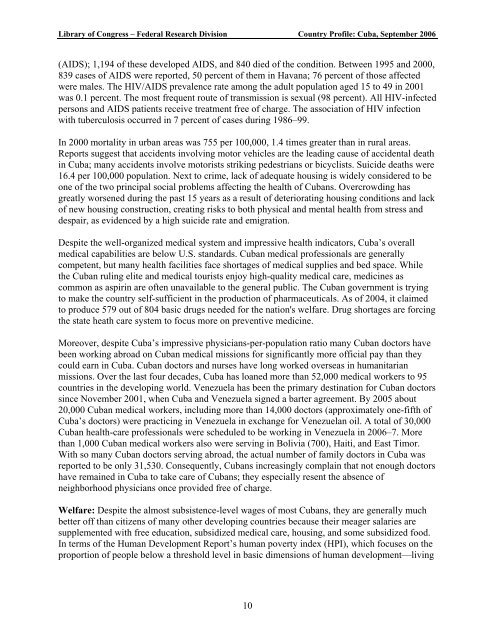Country Profile: Cuba - American Memory - Library of Congress
Country Profile: Cuba - American Memory - Library of Congress
Country Profile: Cuba - American Memory - Library of Congress
You also want an ePaper? Increase the reach of your titles
YUMPU automatically turns print PDFs into web optimized ePapers that Google loves.
<strong>Library</strong> <strong>of</strong> <strong>Congress</strong> – Federal Research Division <strong>Country</strong> <strong>Pr<strong>of</strong>ile</strong>: <strong>Cuba</strong>, September 2006<br />
(AIDS); 1,194 <strong>of</strong> these developed AIDS, and 840 died <strong>of</strong> the condition. Between 1995 and 2000,<br />
839 cases <strong>of</strong> AIDS were reported, 50 percent <strong>of</strong> them in Havana; 76 percent <strong>of</strong> those affected<br />
were males. The HIV/AIDS prevalence rate among the adult population aged 15 to 49 in 2001<br />
was 0.1 percent. The most frequent route <strong>of</strong> transmission is sexual (98 percent). All HIV-infected<br />
persons and AIDS patients receive treatment free <strong>of</strong> charge. The association <strong>of</strong> HIV infection<br />
with tuberculosis occurred in 7 percent <strong>of</strong> cases during 1986–99.<br />
In 2000 mortality in urban areas was 755 per 100,000, 1.4 times greater than in rural areas.<br />
Reports suggest that accidents involving motor vehicles are the leading cause <strong>of</strong> accidental death<br />
in <strong>Cuba</strong>; many accidents involve motorists striking pedestrians or bicyclists. Suicide deaths were<br />
16.4 per 100,000 population. Next to crime, lack <strong>of</strong> adequate housing is widely considered to be<br />
one <strong>of</strong> the two principal social problems affecting the health <strong>of</strong> <strong>Cuba</strong>ns. Overcrowding has<br />
greatly worsened during the past 15 years as a result <strong>of</strong> deteriorating housing conditions and lack<br />
<strong>of</strong> new housing construction, creating risks to both physical and mental health from stress and<br />
despair, as evidenced by a high suicide rate and emigration.<br />
Despite the well-organized medical system and impressive health indicators, <strong>Cuba</strong>’s overall<br />
medical capabilities are below U.S. standards. <strong>Cuba</strong>n medical pr<strong>of</strong>essionals are generally<br />
competent, but many health facilities face shortages <strong>of</strong> medical supplies and bed space. While<br />
the <strong>Cuba</strong>n ruling elite and medical tourists enjoy high-quality medical care, medicines as<br />
common as aspirin are <strong>of</strong>ten unavailable to the general public. The <strong>Cuba</strong>n government is trying<br />
to make the country self-sufficient in the production <strong>of</strong> pharmaceuticals. As <strong>of</strong> 2004, it claimed<br />
to produce 579 out <strong>of</strong> 804 basic drugs needed for the nation's welfare. Drug shortages are forcing<br />
the state heath care system to focus more on preventive medicine.<br />
Moreover, despite <strong>Cuba</strong>’s impressive physicians-per-population ratio many <strong>Cuba</strong>n doctors have<br />
been working abroad on <strong>Cuba</strong>n medical missions for significantly more <strong>of</strong>ficial pay than they<br />
could earn in <strong>Cuba</strong>. <strong>Cuba</strong>n doctors and nurses have long worked overseas in humanitarian<br />
missions. Over the last four decades, <strong>Cuba</strong> has loaned more than 52,000 medical workers to 95<br />
countries in the developing world. Venezuela has been the primary destination for <strong>Cuba</strong>n doctors<br />
since November 2001, when <strong>Cuba</strong> and Venezuela signed a barter agreement. By 2005 about<br />
20,000 <strong>Cuba</strong>n medical workers, including more than 14,000 doctors (approximately one-fifth <strong>of</strong><br />
<strong>Cuba</strong>’s doctors) were practicing in Venezuela in exchange for Venezuelan oil. A total <strong>of</strong> 30,000<br />
<strong>Cuba</strong>n health-care pr<strong>of</strong>essionals were scheduled to be working in Venezuela in 2006–7. More<br />
than 1,000 <strong>Cuba</strong>n medical workers also were serving in Bolivia (700), Haiti, and East Timor.<br />
With so many <strong>Cuba</strong>n doctors serving abroad, the actual number <strong>of</strong> family doctors in <strong>Cuba</strong> was<br />
reported to be only 31,530. Consequently, <strong>Cuba</strong>ns increasingly complain that not enough doctors<br />
have remained in <strong>Cuba</strong> to take care <strong>of</strong> <strong>Cuba</strong>ns; they especially resent the absence <strong>of</strong><br />
neighborhood physicians once provided free <strong>of</strong> charge.<br />
Welfare: Despite the almost subsistence-level wages <strong>of</strong> most <strong>Cuba</strong>ns, they are generally much<br />
better <strong>of</strong>f than citizens <strong>of</strong> many other developing countries because their meager salaries are<br />
supplemented with free education, subsidized medical care, housing, and some subsidized food.<br />
In terms <strong>of</strong> the Human Development Report’s human poverty index (HPI), which focuses on the<br />
proportion <strong>of</strong> people below a threshold level in basic dimensions <strong>of</strong> human development—living<br />
10



![Albert Einstein Papers [finding aid]. Library of Congress. [PDF ...](https://img.yumpu.com/21604228/1/190x245/albert-einstein-papers-finding-aid-library-of-congress-pdf-.jpg?quality=85)





![American Colony in Jerusalem Collection [finding aid]. Library of ...](https://img.yumpu.com/17941275/1/190x245/american-colony-in-jerusalem-collection-finding-aid-library-of-.jpg?quality=85)



![Piccard Family Papers [finding aid]. - American Memory - Library of ...](https://img.yumpu.com/17941234/1/190x245/piccard-family-papers-finding-aid-american-memory-library-of-.jpg?quality=85)


